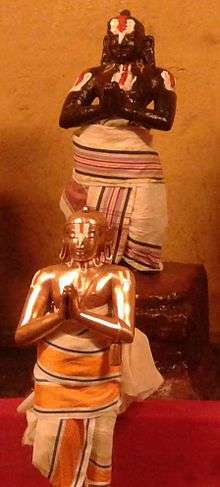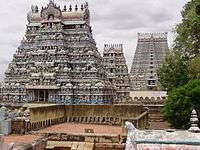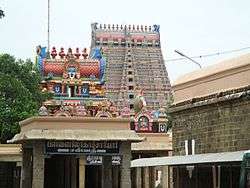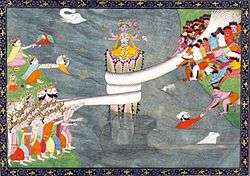Thondaradippodi Alvar
Thondaradippodi Alvar or Vipra Narayana is one of the twelve azhwar saints of South India, who are known for their affiliation to Vaishnava tradition of Hinduism. The verses of azhwars are compiled as Nalayira Divya Prabandham and the 108 temples revered are classified as Divya desam. Thondaripodi is considered the tenth in the line of the twelve azhwars.
Thondaradippodi Alvar | |
|---|---|
 Image of the granite and festival image of Thondaradipodi in Alwarthirunagari Temple | |
| Personal | |
| Born | 8th Century AD Mandangudi |
| Religion | Hinduism |
| Philosophy | Vaishnava Bhakti |
| Religious career | |
| Literary works | Tirumaalai , Tiruppalli Ezuchi |
| Honors | Alvar saint |
As per Hindu legend, he was born as Vipra Narayana and got devoted to Ranganatha of the Srirangam Ranganathaswamy temple. Since he worshipped even the dust from the devotees of Ranganatha, he attained the name Thondaradipodi.
His works are the Tiruppalli Ezuchi having ten verses and Tirumaalai having forty verses, both of which are counted among the 4000 stanzas in the Nalayira Divya Prabandam. The works of Thondaradipodi and other azhwars contributed to the philosophical and theological ideas of Vaishnavism. Along with the three Saiva nayanmars, they influenced the ruling Pallava kings of the South Indian region, resulting in changing the religious geography from Buddhism and Jainism to the two sects of Hinduism.
In South-Indian Vishnu temples, Thondaradipodi azhwar has images and festivals associated with him. The Vasantha Utsavam festival is celebrated in Srirangam and for nine days in the garden believed to have been maintained by him. The verses of Thondaripodi and other azhwars are recited as a part of daily prayers and during festive occasions in most Vishnu temples in South India.
Azhwars
The word azhwar means the one who dives deep into the ocean of the countless attributes of god. Azhwars are considered the twelve supreme devotees of Vishnu, who were instrumental in popularising Vaishnavism during the 5th to 8th centuries AD. The religious works of these saints in Tamil, songs of love and devotion, are compiled as Nalayira Divya Prabandham containing 4000 verses and the 108 temples revered in their songs are classified as Divya desam.[1][2] The saints had different origins and belonged to different castes. As per tradition, the first three azhwars, Poigai, Bhutha and Pei were born miraculously. Bhaktisara was the son of a sage, Thondaradi, Mathurakavi, Vishuchitta and Andal were from brahmin community, Kulasekhara from Kshatria community, Nammazhvar was from a cultivator family, Tirupanar from panar community and Tirumangaiyazhvar from kazhwar community. Divya Suri Carita by Garuda-Vahana Pandita (11th century AD), Guruparamparaprabavam by Pinbaragiya Perumal Jiyar, Periya tiru mudi adaivu by Kovil Kandadai Appan, Yatindra Pranava Prabavam by Pillai Lokam Jeeyar, commentaries on Divya Prabandam, Guru Parampara (lineage of Gurus) texts, temple records and inscriptions give a detailed account of the azhwars and their works. According to these texts, the saints were considered incarnations of some form of Vishnu. Poigai is considered an incarnation of Panchajanya (Krishna's conch), Bhootham of Kaumodakee (Vishnu's Mace/Club), Pey of Nandaka (Vishnu's sword), Bhaktisara of Sudarshana (Vishnu's discus), Nammazhvar of Vishvaksena (Vishnu's commander), Madhurakavi of Vainatheya (Vishnu's eagle, Garuda), Kulasekhara of Kaustubha (Vishnu's necklace), Periy of Garuda (Vishnu's eagle), Andal of Bhoodevi (Vishnu's wife, Lakshmi, in her form as Bhudevi), Thondaradippodi of Vanamaalai (Vishnu's garland), Thiruppaanaazhvar of Srivatsa (An auspicious mark on Vishnu's chest) and Thirumangai of Saranga (Rama's bow). The songs of Prabandam are regularly sung in all the Vishnu temples of South India daily and also during festivals.[2][3]
According to traditional account by Manavala Mamunigal, the first three azhwars namely Poigai, Bhoothath and Pey belong to Dwapara Yuga (before 4200 BC). It is widely accepted by tradition and historians that the trio are the earliest among the twelve azhwars.[1][2][4][5][6] Along with the three Saiva nayanmars, they influenced the ruling Pallava kings, creating a Bhakti movement that resulted in changing the religious geography from Buddhism and Jainism to these two sects of Hinduism in the region. The azhwars were also instrumental in promoting the Bhagavatha cult and the two epics of India, namely, Ramayana and Mahabaratha.[7] The azhwars were instrumental in spreading Vaishnavism throughout the region.[8] The verses of the various azhwars were compiled by Nathamuni (824-924 AD), a 10th-century Vaishnavite theologian, who called it the "Tamil Veda".[9][10]
Birth and early life
Thondaradippodi Alvar was born in a small village by name Thirumandangudi Chola region in Prabhava year, Margazhi month, Krishna chaturthi, Tuesday in Kettai (Jyestha) Nakshatram (star). His father ‘Veda Visaradhar’ belonged to "Kudumi Sozhiyap Brahmanar" community also called as "Vipra" people, whose routine work is to praise about Sri Vishnu. On the 12th day after his birth, he was named as "Vipra Narayanar".[11] From an early age, bhakti towards Sri Vishnu was taught to him. He grew up with a well rounded personality. It is said that in spite of being good and beautiful and dedicated to Sri Vishnu bhakti, he had no conceit and treated all the aged persons and persons who are younger to him in the same way and gave proper respect to them.
As per Hindu legend, he was under the influence of a prostitute, whose mother stole all the money of Vipra Narayanan. When he was need of money, Vishnu came in his rescue and showered gold in him.[12] He became a staunch devotee of Ranganatha of Sriranganathaswamy temple. He constructed a big Nandhavanam (flower park) in Srirangam, where various beautiful and fragrance flower plants are grown. He worshipped all the bhaktas of Sri Vishnu and put the podi (Small tiny dust particles), which is found under the feet of them in his head and sang songs in praise of Sri Ranganathar. From then, he was called as "Thondaradipodi Alwar".[13]
Literary works
He composed Tirumaalai comprising 45 verses and Tiruppalli Ezuchi comprising 10 verses. The verses of Tirupalli Ezhuchi are sung for waking up Rangantha, with the verses beginning with "votary bearing the dust of the god's feet".[14][15] All his verses are in praise of Ranganatha, the presiding deity of the Srirangam Ranganathaswamy temple. Thondaradipodi vehemently opposes the caste system prevalent during his times and mentions that the ultimate way to reach Vishnu is through service to him and his devotees. He believed that Ranganatha is none other than Krishna himself and he has captured his soul.[16] He uses the phrase "Prospering indolents" in his 38th verse meaning the devotees of Vishnu who left their corporal body in earth, but merged their soul to god.[17] His verse starting with "Pachaimamalai pol meni" is the most popular verse and commonly chanted in all Vishnu temples during day-to-day worship and during festivals.[18] The verses of Tirupalli Ezhuchi was first sung in the Srirangam temple and the azhwar gives Ranganatha a wake-up call describing how the inmates of earth come here to watch Ranganatha rise at dawn.[19]
Culture

The birthday of the Azhwar is celebrated twice in a year in the Srirangam temple during the birth star in the Tamil month of Margazhi. The Vasantha utsavam is a nine-day festival celebrated during the Tamil month of Vaikasi (May-June) when Ranganatha, the presiding deity of the temple enjoys the ambience of the garden created by the azhwar. As per a Hindu legend, Thirumangai Azhwar, who built the surrounding walls of the Srirangam temple, left the garden untouched, though it blocked the path of the wall. Spring signifies a period that brings cool breeze in the evenings and new flowers blossom. As per Hindu legend, when Jothista Homam, a penance, when done during the period, helps devotees attain moksha. It is believed that one devotees are liberated from his curse if they drink the sacred water of Vishnu during the festival. During the mid of 15th century during the Vijayanagara rule, the Vasantha Mandapam was built inside the garden for the festive image to spend the evenings during the festival. Every evening during the festival, the festival image of Ranganatha is brought to the garden. In earlier centuries, the Devadasi Community in Srirangam, offered dance performance in front of the festive images of the temple in the Vasantha Mandapam during the festival. The practise is discontinued in the temple, but a practise is still continued at the Puri Jagannath temple. Vasanthotsavam is one of the three festivals of the temple when Ranganathar goes back to his sanctum led by the a set of men singing Divya Prabhandam and also makes a pass by through the Ranganayagi shrine. During the festival, the festival image of Ranganatha is taken in a procession on a horse mount around the four Chitirai streets of Srirangam. A special ablution performed for the festive image at the Vasantha Mandapam concludes the festival.[20][21]
Mangalasasanam
There are 58 of his paasurams in the 4000 Divya Prabhandham. He has sung in praise of six temples.[22]
| S.No. | Name of the temple | Location | Photo | Number of Pasurams | Presiding deity | Notes/Beliefs |
|---|---|---|---|---|---|---|
| 1 | Srirangam. | Srirangam, Trichy district Tamil Nadu 10.8625°N 78.689722°E |
 |
55 | Ranganayagi Ranganathar (Periya Perumal) |
Srirangam temple is often listed as the largest functioning Hindu temple in the world, the still larger Angkor Wat being the largest existing temple. The temple occupies an area of 156 acres (631,000 m²) with a perimeter of 4,116m (10,710 feet) making it the largest temple in India and one of the largest religious complexes in the world.[23][24] The annual 21-day festival conducted during the Tamil month of Margazhi (December–January) attracts 1 million visitors.[25] |
| 2 | Thiruparkadal | Heavenly | 1 | Lakshmi Vishnu |
In Hindu cosmology, Thiruparkadal (Ocean of milk) is the fifth from the center of the seven oceans. It surrounds the continent known as Krauncha.[26] According to Hindu mythology, the devas (gods) and asuras (demons) worked together for a millennium to churn the ocean and release Amrita the nectar of immortal life.[27] It is spoken of in the Samudra manthana chapter of the Puranas, a body of ancient Hindu legends. It is also the place where Vishnu reclines over Shesha Naga, along with his consort Lakshmi. | |
| 3 | Ram Janmabhoomi | 26.7956°N 82.1943°E | 1 | Seetha Ram |
It is the name given to the site that many Hindus believe to be the birthplace of Rama, the 7th avatar of the Hindu deity Vishnu. The Ramayana states that the location of Rama's birthplace is on the banks of the Sarayu river in the city of Ayodhya. A section of Hindus claim that the exact site of Rama's birthplace is where the Babri Masjid once stood in the present-day Ayodhya, Uttar Pradesh. According to this theory, the Mughals demolished a Hindu shrine that marked the spot, and constructed a mosque in its place. People opposed to this theory state that such claims arose only in the 18th century, and that there is no evidence for the spot being the birthplace of Rama. | |
| 4 | Govardana | 27.504748°N 77.669754°E | 1 | Radha Krishna |
The temple in Mathura, is among the most sacred of Hindu sites, and is revered as the birthplace of Krishna.[28] Kehsav Dev (Krishna) is the deity of this temple. According to traditions, the original deity was installed by Bajranabh, who was great-grandson of Krishna.[29] |
Notes
- Rao, P.V.L. Narasimha (2008). Kanchipuram – Land of Legends, Saints & Temples. New Delhi: Readworthy Publications (P) Ltd. p. 27. ISBN 978-93-5018-104-1.
- Dalal 2011, pp. 20-21
- Ramaswamy, Vijaya (2007). Historical Dictionary of the Tamils. Scarecrow Press. p. 211. ISBN 9780810864450.
- Aiyangar, Sakkottai Krishnaswami (1920). Early history of Vaishnavism in south India. Oxford University Press. pp. 17–18.
poigai azhwar.
- Lochtefeld, James (2002). The Illustrated Encyclopedia of Hinduism: N-Z. The Rosen Publishing Group. p. 515. ISBN 9780823931804.
poygai.
- Krishna (2009). Book Of Vishnu. Penguin Books India. p. 136. ISBN 9780143067627.
- B.S. 2011, p. 42
- B.S. 2011, p. 47-48
- Mukherjee (1999). A Dictionary of Indian Literatures: Beginnings-1850 Volume 1 of A Dictionary of Indian Literature, A Dictionary of Indian Literature. Orient Blackswan. p. 15. ISBN 9788125014539.
- Garg, Gaṅgā Rām (1992). Encyclopaedia of the Hindu World: Ak-Aq. Concept Publishing Company. pp. 352–354. ISBN 9788170223757.
- Rajarajan, R.K.K. "Master-Slave Ambivalence in the hagiography of the Āḻvārs". Cite journal requires
|journal=(help) - B.S. 2011, p. 45
- Rajarajan, R.K.K. (2016). "Master-Slave Ambivalence in the hagiography of the Āḻvārs". The Quarterly Journal of the Mythic Society. 107.1: 44–60.
- Taylor, William (1857). A catalogue raisonné of oriental manuscripts in the Government Library, Volume 1. United Scottish Press. p. 517.
- Taylor, William Cooke (1857). A Catalogue raisonnee[!] of oriental manuscripts in the library of the (late) college, Fort Saint George, Volume 1. H.Smith. p. 517.
tondaradi.
- T., Padmaja (2002). Temples of Kr̥ṣṇa in South India: history, art, and traditions in Tamilnāḍu. New Delhi: Shakti Malik. p. 57. ISBN 81-7017-398-1.
- Govindāchārya 1902, p. 77
- "Vocalist wins appreciation". The Hindu. 1 December 2011. Retrieved 7 July 2013.
- Nandakumar, Prema (24 December 2012). "Where Kamban released his Ramayana". The Hindu. Retrieved 7 July 2013.
- "Temple calendar of Srirangam temple -2011" (PDF). Srirangam Ranganthaswamy temple administration. 2011. Retrieved 7 July 2013.
- S., Prabhu (11 June 2010). "Devotion in romantic setting". The Hindu. Retrieved 7 July 2013.
- Pillai, M. S. Purnalingam (1904). A Primer of Tamil Literature. Madras: Ananda Press. pp. 182–83.
- Mittal, Sushil; Thursby, G.R. (2005). The Hindu World. New York: Routelge. p. 456. ISBN 0-203-67414-6.
- Vater, Tom (2010). Moon Spotlight Angkor Wat. USA: Perseus Books Group. p. 40. ISBN 9781598805611.
- Jones, Victoria (2004). Wonders of the World Dot-to-Dot. New York: Sterling Publishing Co., Inc. p. 4. ISBN 1-4027-1028-3.
- Hudson, D. Dennis (2008). The body of God: an emperor's palace for Krishna in eighth-century Kanchipuram. Oxford University Press US. pp. 164–168. ISBN 978-0-19-536922-9.
- "Churning the Ocean of Milk by Michael Buckley".
- Saiyid Zaheer Husain Jafri (1 January 2009). Transformations in Indian History. Anamika Publishers & Distributors. pp. 299–. ISBN 978-81-7975-261-6. Retrieved 7 July 2012.
- D. Anand (1 January 1992). Krishna: The Living God of Braj. Abhinav Publications. pp. 29–. ISBN 978-81-7017-280-2. Retrieved 7 July 2012.
References
- B. S., Chandrababu; S., Ganeshram; C., Bhavani (2011). History of People and Their Environs. Bharathi Puthakalayam. ISBN 9789380325910.
- Chari, S. M. Srinivasa (1997). Philosophy and Theistic Mysticism of the Āl̲vārs. Motilal Banarsidass Publishers. ISBN 9788120813427.
- Dalal, Roshen (2011). Hinduism: An Alphabetical Guide. Penguin Books India. ISBN 9780143414216.
- Das, Sisir Kumar; Sāhitya Akādemī (2005). A history of Indian literature, 500-1399: from courtly to the popular. chennai: Sāhitya Akādemī. ISBN 81-260-2171-3.
- Govindāchārya, Aḷkoṇḍavilli (1902). The Holy Lives of the Azhvârs: Or, the Drâvida Saints. Mysore: G. T. A. Press.
periyazhvar.
- Ramanujan, Attipat Krishnaswami (2005). Hymns for the Drowning: Poems for Vishnu. Penguin Books. ISBN 9780144000104.
